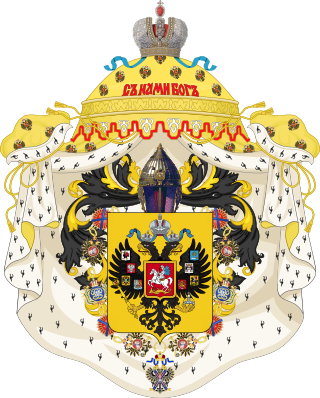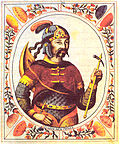List of Russian monarchs
From Wikipedia, the free encyclopedia
This is a list of all reigning monarchs in the history of Russia. The list begins with the semi-legendary prince Rurik of Novgorod, sometime in the mid-9th century, and ends with Nicholas II, who abdicated in 1917, and was executed with his family in 1918. Two dynasties have ruled Russia: the Rurikids (862–1598) and Romanovs (from 1613).[1][2]
| Monarchy of Russia | |
|---|---|
 | |
 Visualisation of Russian monarchs as a tree (1886) | |
| Details | |
| Style | His/Her Imperial Majesty |
| First monarch | Rurik (as Prince) |
| Last monarch | Nicholas II (as Emperor) |
| Formation | 862 |
| Abolition | 15 March 1917 |
| Residence | Winter Palace, Moscow Kremlin |
| Appointer | Hereditary |
| Pretender(s) | |
The vast territory known as Russia covers an area that has been ruled by various polities since the 9th century, including Kievan Rus', the Grand Principality of Vladimir, the Grand Principality of Moscow, the Tsardom of Russia and the Russian Empire, and the sovereigns of these polities have used a range of titles. Some of the earliest titles include knyaz and veliky knyaz, which mean "prince" and "grand prince" respectively, and have sometimes been rendered as "duke" and "grand duke" in Western literature. After the centralized Russian state was formed, this was followed by the title of tsar, meaning "caesar", which was disputed to be the equal of either a king or emperor, and finally the title of emperor.
According to Article 59 of the 1906 Russian constitution, the Russian emperor held several dozen titles, each one representing a region which the monarch governed.[3]
Rurikids (862–1598)
Summarize
Perspective
Princes of Novgorod
In traditional historiography, the first Russian monarch is considered to be the semi-legendary Rurik, the first prince of Novgorod.[a][5][6][7]
Grand princes of Kiev
Rurik's successor Oleg moved his capital to Kiev, founding a state denoted in modern historiography as Kievan Rus' (Russian: Киевская Русь) or Ancient Rus' (Russian: Древняя Русь, Древнерусское государство).[9] Over the next several centuries, the most important titles were grand prince of Kiev and prince of Novgorod, whose holder (often the same person) could claim hegemony.
| Name | Lifespan | Reign start | Reign end | Notes | Family | Image |
|---|---|---|---|---|---|---|
Oleg[10][8]
| 855–912 | c. 882 | c. 912 | Successor of Askold and Dir as a regent for Rurik's son | Rurikids |  |
Igor I[11][8]
| 878–945 | c. 912 | 945 | Son of Rurik | Rurikids | 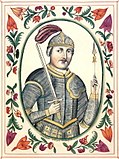 |
Sviatoslav I[12][8]
| 942–972 | 945[13] | March 972 | Son of Igor I and Olga Regent: Olga of Kiev[8] (945–957) | Rurikids |  |
Yaropolk I[14]
| 950–980 | March 972 | 11 June 980 | Son of Sviatoslav I and Predslava | Rurikids |  |
Saint Vladimir I[15][8]
| 958–1015 | 11 June 980 | 15 July 1015 | Son of Sviatoslav I and Malusha Younger brother of Yaropolk I | Rurikids |  |
Sviatopolk I[16][8]
| 980–1019 | 1015 | 1019 | Son of Vladimir I Overthrown by Yaroslav of Novgorod | Rurikids |  |
Yaroslav I[17][8]
| 978–1054 | Autumn 1016 | 22 July 1018 | Son of Vladimir I and Rogneda of Polotsk Prince of Novgorod since 1010 | Rurikids |  |
Sviatopolk I
| 980–1019 | 14 August 1018 | 27 July 1019 | Restored. Fled from Kiev after defeat from Yaroslav on Alta River | Rurikids |  |
Yaroslav I
| 978–1054 | 27 July 1019 | 20 February 1054 | Restored Co-ruler: Mstislav of Chernigov (1024–1036) | Rurikids |  |
Feudal period
The gradual disintegration of Kievan Rus' began in the 11th century, after the death of Yaroslav the Wise. The position of the grand prince was weakened by the growing influence of regional clans. In 1097, the Council of Liubech formalized the feudal nature of the lands. The Liubech conference resulted in the creation of a federative structure, with the different principalities within the structure remaining bound to Kiev as the center of the state. This structure allowed for some of the principalities to develop into semi-independent polities, with conflict between the principalities intensifying in the 12th century.[18]
| Name | Lifespan | Reign start | Reign end | Notes | Family | Image |
|---|---|---|---|---|---|---|
Iziaslav I[19][8]
| 1024–1078 | 20 February 1054 | 15 September 1068 | First son of Yaroslav I and Ingegerd Olofsdotter. Overthrown | Rurikids |  |
Vseslav[20][8]
| 1039–1101 | 15 September 1068 | 29 April 1069 | Great-grandson of Vladimir I Usurped the Kievan throne Prince of Polotsk (1044–67, 1071–1101) | Rurikids |  |
Iziaslav I[21]
| 1024–1078 | 2 May 1069 | 22 March 1073 | Restored | Rurikids |  |
Sviatoslav II[22][8]
| 1027–1076 | 22 March 1073 | 27 December 1076 | Third son of Yaroslav I and Ingegerd Olofsdotter Prince of Chernigov (1054–73) | Rurikids |  |
Vsevolod I[23][8]
| 1030–1093 | 1076[13] | 15 July 1077 | Fourth son of Yaroslav I and Ingegerd Olofsdotter Handed over the throne to Iziaslav I Prince of Pereyaslavl (1054–73), Chernigov (1073–78). The first known of the Kiev princes to bear the title of "Prince of all Rus′" | Rurikids | 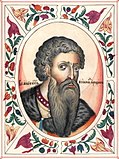 |
Iziaslav I[24]
| 1024–1078 | 15 July 1077 | 3 October 1078 | Restored | Rurikids |  |
Vsevolod I[25]
| 1030–1093 | 3 October 1078 | 13 April 1093 | Retook the throne after Iziaslav's death | Rurikids |  |
Sviatopolk II[26]
| 1050–1113 | 24 April 1093 | 16 April 1113 | Son of Iziaslav I Prince of Novgorod (1078–88), Turov (1088–93) | Rurikids |  |
Vladimir II[27][8]
| 1053–1125 | 20 April 1113 | 19 May 1125 | Son of Vsevolod I and Anastasia of Byzantium Prince of Smolensk (1073–78), Chernigov (1078–94), Pereyaslavl (1094–1113) | Rurikids | 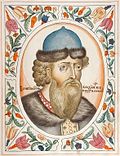 |
Mstislav I[28][8]
| 1076–1132 | 20 May 1125 | 15 April 1132 | Son of Vladimir II and Gytha of Wessex Prince of Novgorod (1088–1117), Belgorod (1117–25) | Rurikids |  |
After Mstislav's death in 1132, Kievan Rus' fell into recession and a rapid decline, marking the end of a unified state.[29] The throne of Kiev became an object of struggle between various territorial associations of Rurikid princes in the decades to come, despite Kiev losing almost all of its former glory and power.[30]
| Name | Lifespan | Reign start | Reign end | Notes | Family | Image |
|---|---|---|---|---|---|---|
Yaropolk II[31][8]
| 1082–1139 | 17 April 1132 | 18 February 1139 | Son of Vladimir II and Gytha of Wessex Younger brother of Mstislav I Prince of Pereyaslavl (1114–32) | Rurikids |  |
Viacheslav[32][8]
| 1083 – 2 February 1154 | 22 February 1139 | 4 March 1139 | Son of Vladimir II and Gytha of Wessex Prince of Smolensk (1113–27), Turov, Pereyaslavl | Rurikids |  |
Vsevolod II[33]
| 1084–1146 | 5 March 1139 | 30 July 1146 | Grandson of Sviatoslav II via Oleg of Chernigov Prince of Chernigov (1127–39) | Rurikids |  |
Saint Igor II[34]
| 1096 – 19 September 1146 | 1 August 1146 | 13 August 1146 | Younger brother of Vsevolod II. Overthrown | Rurikids | 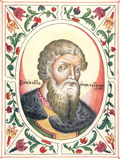 |
Iziaslav II[35][8]
| 1097–1154 | 13 August 1146 | 23 August 1149 | Son of Mstislav I and Christina Ingesdotter of Sweden | Rurikids |  |
Yuri I[8]
| 1099–1157 | 28 August 1149 | Summer 1150 | Son of Vladimir II and Gytha of Wessex Fled from Kiev when Iziaslav's troops were approaching the city Prince of Rostov and Suzdal (1113–49, 1151–57) | Rurikids | 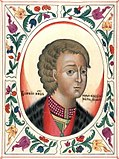 |
Viacheslav
| 1083 – 2 February 1154 | Summer 1150 | Summer 1150 | Restored. Agreed to cede the throne seeing the support of Iziaslav by the townspeople | Rurikids |  |
Iziaslav II
| 1097–1154 | Summer 1150 | Summer 1150 | Restored. Fled to Vladimir-Volynsky under the threat of Yuri's attack | Rurikids |  |
Yuri I
| 1099–1157 | August 1150 | Winter 1151 | Restored | Rurikids |  |
Iziaslav II
| 1097–1154 | Winter 1151 | 13 November 1154 | Restored Co-ruler: Viacheslav | Rurikids |  |
Viacheslav
| 1083 – December 1154 | Spring 1151 | December 1154 | Restored as Iziaslav's senior co-ruler. After Iziaslav's death Rostislav of Smolensk was proclaimed Viacheslav's new co-prince | Rurikids |  |
Rostislav
| 1110–1167 | 1154 | January 1155 | Son of Mstislav I and Christina Ingesdotter of Sweden, younger brother of Iziaslav II Left Kiev after defeat from Iziaslav of Chernigov | Rurikids |  |
Iziaslav III[36]
| 12th century | January 1155 | 1155 | Grandson of Sviatoslav II via Davyd of Chernigov. Ceded the Kiev throne to Yuri the Long Hands Prince of Chernigov (1151–57) | Rurikids |  |
Yuri I[37]
| 1099–1157 | 20 March 1155 | 15 May 1157 | Restored | Rurikids |  |
Iziaslav III[38]
| 12th century | 19 May 1157 | December 1158 | Restored. Defeated by Mstislav of Volhynia | Rurikids |  |
Mstislav II[39]
| 1125–1170 | 22 December 1158 | Spring 1159 | Son of Iziaslav II. Сeded the throne to Rostislav | Rurikids |  |
Rostislav[40]
| 1110–1167 | 12 April 1159 | 8 February 1161 | Restored. Overthrown by Iziaslav and fled to Belgorod | Rurikids |  |
Iziaslav III[41]
| 12th century | 12 February 1161 | 6 March 1161 | Restored. Mortally wounded after failed siege of Belgorod | Rurikids |  |
Rostislav[42]
| 1110–1167 | March 1161 | 14 March 1167 | Restored | Rurikids |  |
Mstislav II[43]
| 1125–1170 | 19 May 1167 | 12 March 1169 | Restored | Rurikids |  |
In March 1169, a coalition of princes led by the grand prince of Vladimir, Andrey Bogolyubsky, sacked Kiev and forced the ruling prince, Mstislav II, to flee to Volhynia. Andrei appointed his brother, Gleb, as the prince of Kiev,[44] while Andrei himself continued to rule his realm from Vladimir-on-the-Klyazma. Andrei styled himself as the grand prince of Vladimir, although the less important prince in Kiev would still bear the title of grand prince; the last prince to bear the title of grand prince of Kiev was Michael of Chernigov, who died in 1246, while the grand princes of Vladimir retained their title.[30] The other future grand princely titles were derived from the grand princely title of Vladimir.[30]
From that time onwards, Vladimir became one of the most influential principalities. In the south-west, the principality of Galicia-Volhynia began to emerge as a local successor to Kiev. Following the Mongol invasions, three powerful states emerged: the Grand Principality of Vladimir in the north-east, which would evolve into the Grand Principality of Moscow and become the center of the autocratic Russian state; the Kingdom of Galicia–Volhynia in the south-west, which was later annexed by Poland and Lithuania; and the Novgorod Republic in the north.[45]
Grand princes of Vladimir
By the 12th century, the Grand Principality of Vladimir became the dominant principality in the north-east, adding its name to those of Novgorod and Kiev, culminating with the rule of Alexander Nevsky. In 1169, Andrey I's son sacked the city of Kiev, but Andrey instead stayed in Vladimir and made it his capital, while taking the title of grand prince to claim primacy, leading to political power being shifted to the north-east.[46][47]
| Name | Lifespan | Reign start | Reign end | Notes | Family | Image |
|---|---|---|---|---|---|---|
Saint Andrey I[48][8]
| c.1111–1174 | 15 May 1157 | 29 June 1174 | Son of Yuri I Assassinated by local nobility | Rurikids |  |
Mikhalko[49]
| 12th century | 1174 | September 1174 | Son of Yuri I Younger brother of Andrey I | Rurikids |  |
Yaropolk III
| 12th century | 1174 | 15 June 1175 | Grandson of Yuri I | Rurikids |  |
Mikhalko
| 12th century | 15 June 1175 | 20 June 1176 | Restored | Rurikids |  |
Vsevolod III[50][8]
| 1154–1212 | June 1176 | 15 April 1212 | Son of Yuri I and Helene Younger brother of Andrey I and Mikhalko | Rurikids |  |
Yuri II[51][8]
| 1189–1238 | 1212 | 27 April 1216 | Son of Vselovod III and Maria Shvarnovna | Rurikids |  |
Konstantin[52]
| 1186–1218 | Spring 1216 | 2 February 1218 | Son of Vsevolod III and Maria Shvarnovna Elder brother of Yuri II | Rurikids |  |
Yuri II[53]
| 1189–1238 | February 1218 | 4 March 1238 | Restored | Rurikids |  |
Following the Mongol invasions, the principalities started paying tribute to the Golden Horde (the so-called "Tatar yoke"). Until the 15th century, Russian princes received a yarlyk from the khan; it was not until about 1480 that the Mongol domination of Russia formally ended.[45]
| Name | Lifespan | Reign start | Reign end | Notes | Family | Image |
|---|---|---|---|---|---|---|
Yaroslav II[54][8]
| 1191–1246 | 1238 | 30 September 1246 | Son of Vsevolod III and Maria Shvarnovna Younger brother of Yuri II and Konstantin of Rostov Also Grand Prince of Kiev in 1236–38 and since 1243 | Rurikids |  |
Sviatoslav III[55][8]
| 1196 – 3 February 1252 | 1246 | 1248 | Son of Vsevolod III and Maria Shvarnovna Younger brother of Yuri II, Konstantin of Rostov and Yaroslav II | Rurikids |  |
Mikhail
| 1229 – 15 January 1248 | 1248 | 15 January 1248 | Son of Yaroslav II | Rurikids |  |
Sviatoslav III
| 1196 – 3 February 1252 | 1248 | 1249 | Restored | Rurikids |  |
Andrey II[56][8]
| 1222–1264 | December 1249 | 24 July 1252 | Son of Yaroslav II Elder brother of Mikhail Khorobrit | Rurikids |  |
Saint Alexander[57][8]
| 1221–1263 | 1252 | 14 November 1263 | Son of Yaroslav II and Rostislava Mstislavna, daughter of Kievan Rus' Prince Mstislav Mstislavich the Bold Elder brother of Mikhail Khorobrit and Andrey II Prince of Novgorod three times, Grand Prince of Kiev since 1249 | Rurikids |  |
After the death of Alexander Nevsky, the Grand Principality of Vladimir split into various appanage principalities, with Alexander's youngest son Daniel being the first permanent ruler of Moscow.[58] The territory of Vladimir proper was received by the Horde to one of the appanage princes, who performed the enthronement ceremony in Vladimir, but remained to live and reign in his own principality. By the end of the century, only three cities – Moscow, Tver, and Nizhny Novgorod – still contended for the title of grand prince of Vladimir.[30] The grand princely title occasionally reverted to Tver, but in the end, the Moscow branch of Rurikids established by Daniel successfully claimed the title for themselves exclusively.[30]
Ivan I was able to collect tribute from the Russian princes to the Golden Horde and his reign saw a significant strengthening of Moscow as Ivan increased its wealth and purchased more land, including entire appanages from bankrupt princes.[59] Ivan was also able to convince the head of the Russian Orthodox Church to move to Moscow, and Vladimir remained in the hands of the princes of Moscow.[60] Ivan's son Simeon was the first prince to adopt the style of grand prince of Moscow and Vladimir.[30]
The princes of Moscow and Suzdal entered a struggle for the grand princely title following the death of Ivan II, with Ivan's son Dmitry Ivanovich (later known as Dmitry Donskoy) taking the throne from Dmitry Konstantinovich in 1363.[61] The Battle of Kulikovo in 1380 marked a turning point, with the prince of Moscow seen as the dominant prince.[62]
| Name | Lifespan | Reign start | Reign end | Notes | Family | Image |
|---|---|---|---|---|---|---|
Yaroslav III[63][8]
| 1230–1272 | 1264 | 1271 | Son of Yaroslav II and Fedosia Igorevna Younger brother of Alexander Nevsky, Andrey II and Mikhail Khorobrit | Rurikids |  |
Vasily[64][8]
| 1241–1276 | 1272 | January 1277 | Son of Yaroslav II | Rurikids |  |
Dmitry[65][8]
| 1250–1294 | 1277 | 1281 | Son of Alexander Nevsky | Rurikids |  |
Andrey III[66][8]
| 1255–1304 | 1281 | December 1283 | Son of Alexander Nevsky Younger brother of Dmitry of Pereslavl | Rurikids |  |
Dmitry[67]
| 1250–1294 | December 1283 | 1293 | Restored | Rurikids |  |
Andrey III[68]
| 1255–1304 | 1293 | 27 July 1304 | Restored | Rurikids |  |
Saint Mikhail[69][8]
| 1271–1318 | Autumn 1304 | 22 November 1318 | Son of Yaroslav III and Xenia of Tarusa Murdered | Rurikids |  |
Yuri III[70][8]
| 1281–1325 | 1318 | 2 November 1322 | Grandson of Alexander Nevsky | Rurikids | 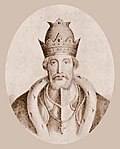 |
Dmitry[71][8]
| 1299–1326 | 1322 | 15 September 1326 | Son of Michael of Tver and Anna of Kashin Murdered | Rurikids |  |
Alexander[72][8]
| 1301–1339 | 1326 | 1327 | Son of Michael of Tver and Anna of Kashin Younger brother of Dmitry | Rurikids |  |
Alexander[73]
| 14th century | 1328 | 1331 | Grandson of Andrey II Co-ruler: Ivan I of Moscow | Rurikids |  |
Ivan I[74][8]
| 1288–1340 | 1328 | 31 March 1340 | Grandson of Alexander Nevsky Son of Daniel of Moscow Younger brother of Yuri III Co-ruler: Alexander of Suzdal (until 1331) | Rurikids |  |
Simeon[75][8]
| 7 September 1317 – 27 April 1353 | 1 October 1340 | 27 April 1353 | Son of Ivan I and Helena | Rurikids |  |
Ivan II[76][8]
| 30 March 1326 – 13 November 1359 | 25 March 1354 | 13 November 1359 | Son of Ivan I and Helena Younger brother of Simeon | Rurikids |  |
Dmitry[77][8]
| 1322 – 5 July 1383 | 22 June 1360 | December 1362 | Son of Konstantin Vasilyevich of Suzdal | Rurikids |  |
Saint Dmitry[78]
| 12 October 1350 – 19 May 1389 | January 1363 | 19 May 1389 | Son of Ivan II and Alexandra Velyaminova Prince of Moscow since 1359 | Rurikids |  |
After the death of Dmitry Donskoy, the throne of Vladimir was passed to the prince of Moscow, thus usurping the right of the khan to appoint the grand prince.[79][80] The grand princes of Moscow later adopted the title of sovereign and grand prince of all Russia,[81][30] with the unification of other principalities with Moscow cultivating a sense of an imperial role for the grand prince as the ruler of all Russia.[82]
Grand princes of Moscow
The Russians began to exert independence from the Mongols, culminating with Ivan III ceasing tribute to the Horde, effectively declaring his independence. Ivan III also greatly expanded his domain with the annexations of other principalities;[83] his son Vasili III completed the task of uniting all of Russia by annexing the last few independent states in the 1520s.[84]
Princely succession in medieval Russia proceeded along the lines of the eldest son usually being the being chosen, with the condition that substitution did not take place if the father died before the grandfather.[85] The grand princes of Moscow, once they entrenched their status as the supreme prince with regard to other Russian princes, typically left a will in which they appointed their eldest son as heirs to the title of grand prince;[85] this did not fully conform to traditional succession practices, and in 1497, Ivan III went one step further by crowning his grandson Dmitry as co-ruler, bypassing his son Vasily, who, according to the traditional system, would have been the heir, although in the end Vasily was made co-ruler and this arrangement did not work out.[86] Ivan III also used the title of tsar in his foreign correspondence, but it would be his grandson Ivan IV who would be crowned as the first Russian tsar.[87][88]
| Name | Lifespan | Reign start | Reign end | Notes | Family | Image |
|---|---|---|---|---|---|---|
Vasily I[89][8]
| 30 December 1371 – 27 February 1425 | 19 May 1389 | 27 February 1425 | Son of Dmitry I and Eudoxia Dmitriyevna | Rurikids |  |
Vasily II[90][8]
| 10 March 1415 – 27 March 1462 | 27 February 1425 | 30 March 1434 | Son of Vasily I and Sophia of Lithuania. Deposed Regent: Sophia of Lithuania (1425–1432) | Rurikids |  |
Yuri (IV)
| 26 November 1374 – 5 June 1434 | 31 March 1434 | 5 June 1434 | Son of Dmitry I and Eudoxia Dmitriyevna Younger brother of Vasily I | Rurikids |  |
Vasily
| 1421 – 1448 | 5 June 1434 | 1435 | Son of Yury of Zvenigorod and Anastasia of Smolensk | Rurikids |  |
Vasily II
| 10 March 1415 – 27 March 1462 | 1435 | 1446 | Restored | Rurikids |  |
Dmitry
| 1400s – 17 July 1453 | 1446 | 26 March 1447 | Son of Yury of Zvenigorod and Anastasia of Smolensk, brother of Vasily the Squint First to use the title of Sovereign of all Russia[91] | Rurikids |  |
Vasily II
| 10 March 1415 – 27 March 1462 | 27 February 1447 | 27 March 1462 | Restored Co-ruler: Ivan (since 1449) | Rurikids |  |
Ivan III[92][8]
| 22 January 1440 – 6 November 1505 | 5 April 1462 | 6 November 1505 | Son of Vasily II and Maria of Borovsk Co-rulers: Ivan the Young (1471–1490), Dmitry the Grandson (1498–1502), Vasily (since 1502) | Rurikids |  |
Vasily III[93][8]
| 25 March 1479 – 13 December 1533 | 6 November 1505 | 13 December 1533 | Son of Ivan III and Sophia Paleologue | Rurikids |  |
Ivan IV[94]
| 25 August 1530 – 28 March 1584 | 13 December 1533 | 26 January 1547 | Son of Vasily III and Elena Glinskaya Regent: Elena Glinskaya (1533–1538) | Rurikids |  |
Tsars of Russia
Ivan IV ("the Terrible") assumed the title of tsar in 1547. Succession was treated in an unorthodox manner under Ivan IV, who, in 1575, formally transferred his powers to Simeon Bekbulatovich, a Tatar prince who had been baptized and given his own principality;[95] Ivan returned to the throne the following year.[95] Ivan was succeeded in 1584 by his only surviving son, Feodor, who died without an heir, marking the end of the Rurik dynasty.[95]
| Name | Lifespan | Reign start | Reign end | Notes | Family | Image |
|---|---|---|---|---|---|---|
Ivan IV[96][8]
| 25 August 1530 – 28 March 1584 | 26 January 1547 | 28 March 1584 | Son of Vasily III and Elena Glinskaya "Grand Prince": Simeon Bekbulatovich (1575–1576) | Rurikids |  |
Feodor I[97][8]
| 31 May 1557 – 17 January 1598 | 28 March 1584 | 17 January 1598 | Son of Ivan IV and Anastasia Zakharyina-Yuryeva | Rurikids |  |
Time of Troubles (1598–1613)
Summarize
Perspective
Tsars of Russia
In 1581, Ivan the Terrible killed his firstborn son Ivan Ivanovich in a fit of rage, leaving only Feodor I to succeed him.[95] Feodor died childless, marking the end of the Rurik dynasty and the start of a succession crisis during a period known as the Time of Troubles.[95] The first non-Rurikid tsar was Feodor's brother-in-law and regent, the influent boyar Boris Godunov, elected by the Zemsky Sobor (feudal parliament).
| Name | Lifespan | Reign start | Reign end | Notes | Family | Image |
|---|---|---|---|---|---|---|
Irina[98] (disputed)
| 1557 – 27 October 1603 | 17 January 1598 | 21 February 1598 | Wife of Feodor I | Godunov |  |
Boris[94][8]
| 1551 – 13 April 1605 | 21 February 1598 | 13 April 1605 | Brother-in-law of Feodor I Elected by Zemsky Sobor | Godunov |  |
Feodor II[99][8]
| 1589 – 20 June 1605 | 13 April 1605 | 10 June 1605 | Son of Boris Godunov and Maria Grigorievna Skuratova-Belskaya Murdered | Godunov |  |
Devastated by famine, rule under Boris descended into anarchy. There followed a series of impostors, known as the False Dmitrys, each claiming to be Feodor I's long deceased younger brother; however, only the first impostor ever took the capital and sat on the throne. A distant Rurikid cousin, Vasily Shuysky, also took power for a time. During this period foreign powers deeply involved themselves in Russian politics, under the leadership of the Vasa monarchs of Sweden and Poland-Lithuania, including Sigismund III Vasa and his son Władysław. As a child, Władysław was even chosen as tsar by the council of aristocracy, though he was prevented by his father from formally taking the throne. The Time of Troubles is considered to have ended with the election of Michael Romanov to the throne in February 1613, thereby establishing the Romanov dynasty.[95]
| Name | Lifespan | Reign start | Reign end | Notes | Family | Image |
|---|---|---|---|---|---|---|
False Dmitry I[100][8]
| 1581 – 17 May 1606 | 20 June 1605 | 17 May 1606 | Claiming to be son of Ivan IV, he was the only impostor to actually sit on the throne of a major power. Backed by Polish–Lithuanian Commonwealth. Murdered. | Rurikids (claimed) |  |
Vasily IV[101][8]
| 22 September 1552 – 12 September 1612 | 19 May 1606 | 17 July 1610 | Orchestrated a conspiracy against False Dmitry, proclaimed tsar by the nobles. Deposed and sent to Poland Pretender: False Dmitry II (since June 1607) | Shuysky |  |
Vladislav
| 9 June 1595 – 20 May 1648 | 6 September 1610 | November 1612 (resigned his claim in 1634) | King of Poland from 1632 to 1648 Son of Sigismund III Vasa and Anne of Austria Elected by the Seven Boyars, never assumed the throne Pretenders: False Dmitry II (until 21 December 1610), False Dmitry III (July 1611 – May 1612) | Vasa |  |
Romanovs (1613–1917)
Summarize
Perspective
Tsars of Russia
The Time of Troubles came to a close with the election of Michael Romanov as tsar in 1613.[95] Michael officially reigned as tsar, though his father, the patriarch Philaret (died 1633) initially held de facto power. However, Michael's descendants would rule Russia, first as tsars and later as emperors, until the Russian Revolution of 1917. Michael was succeeded by his only son, Alexis, who in turn was succeeded by his eldest son of his first marriage, Feodor.[95]
Following the death of Feodor, there were two candidates for the throne: his brother Ivan and his half-brother Peter, who were fifteen and nine years old, respectively.[95] Each candidate was supported by a competing clan, the Miloslavskys and Naryshkins.[95] At first, the throne was given to Peter, but as a result of the streltsy uprising in Moscow, a compromise solution was found and both Peter and Ivan were made co-monarchs in 1682, with Ivan's older sister Sophia ruling as regent.[95] Ivan was considered the senior tsar and Peter the junior tsar; however, due to Ivan being considered unfit for the role, Peter was able to remove his half-sister Sophia from power and take control of the throne at the age of 17 with the assistance of another streltsy uprising in 1689.[102] Peter then became the sole monarch in 1696 upon the death of Ivan.[102]
| Name | Lifespan | Reign start | Reign end | Notes | Family | Image |
|---|---|---|---|---|---|---|
Michael[103][104]
| 12 July 1596 – 12 July 1645 | 26 July 1613 | 12 July 1645 | Founder of Romanov Dynasty First cousin once removed of Feodor I Co-ruler: Patriarch Filaret (1619–1633) | Romanov |  |
Alexis[105][104]
| 9 May 1629 – 29 January 1676 | 12 July 1645 | 29 January 1676 | Son of Michael and Eudoxia Streshneva | Romanov |  |
Feodor III[106][104]
| 9 June 1661 – 7 May 1682 | 29 January 1676 | 7 May 1682 | Son of Alexis and Maria Miloslavskaya | Romanov |  |
Ivan V[107][104]
| 6 September 1666 – 8 February 1696 | 7 May 1682 | 8 February 1696 | Son of Alexis and Maria Miloslavskaya Younger brother of Feodor III and Sophia Elder half-brother of Peter I Co-ruler: Peter I Regent: princess Sophia (8 June 1682 – 17 September 1689) | Romanov |  |
Peter I[108][104]
| 9 June 1672 – 8 February 1725 | 7 May 1682 | 2 November 1721 | Son of Alexis and Natalya Naryshkina Younger half-brother of Feodor III Co-ruler: Ivan V (7 May 1682 – 8 February 1696) Regent: tsaritsa dowager Natalia (7 May – 2 June 1682), princess Sophia (8 June 1682 – 17 September 1689) | Romanov |  |
Emperors of Russia
The Russian Empire was proclaimed by Peter the Great in 1721 following the creation of the imperial title in the aftermath of the Great Northern War.[109] Russia's territorial gains and increased standing as a key player on the European scene allowed it to upgrade its official status from tsardom to empire.[109] The full imperial title proposed in 1721 to Peter was "Father of the Fatherland, Peter the Great, All-Russian Emperor".[109] At his accession as the sole monarch of Russia in 1696, Peter held the same title as his father, Alexis: "Great Lord Tsar and Grand Prince, Autocrat of Great, Small and White Russia".[109] By 1710, he had styled himself as "Tsar and All-Russian Emperor", but it was not until 1721 that the imperial title became official.[109] The adjective "All-Russian" had been increasingly used to refer to the territories of modern-day Belarus and Ukraine as well.[85]
Peter issued a decree in 1722 in which the sovereign would be free to appoint a successor, referring to a number of historical precedents, including the conduct of Ivan III, who initially chose his grandson as his successor.[110] This was later detailed in Pravda voli Monarshei v opredelenii Naslednika Derzhavy Sovei ("The righteousness of the monarch's will in appointing the successor in his reign"), a major political treatise written in its defense,[111] which was only circulated widely following Peter's death, and argued on the basis of an abundance of examples from both biblical and secular history that it was fully correct for a ruler to appoint his own successor without being bound by traditional family succession rules.[110] Peter died in 1725 without naming a successor.[110]
Officially, Russia would be ruled by the Romanov dynasty until the Russian Revolution of 1917. However, direct male descendants of Michael Romanov came to an end in 1730 with the death of Peter II of Russia, grandson of Peter the Great. The throne passed to Anna, a niece of Peter the Great, and after the brief rule of her niece's infant son Ivan VI, the throne was seized by Elizabeth, a daughter of Peter the Great. Elizabeth would be the last of the direct Romanovs to rule Russia. Elizabeth declared her nephew, Peter, to be her heir. Peter, who would rule as Peter III, was a German prince (with a Romanov mother) of the House of Holstein-Gottorp before arriving in Russia to assume the imperial title. He and his German wife Sophia (who had distant Rurikid ancestry) changed their name to Romanov upon inheriting the throne. Peter was ill-liked, and he was assassinated within six months of assuming the throne, in a coup orchestrated by his wife, who became Empress in her own right and ruled as Catherine the Great. Their son Paul I was the first monarch who had both Rurikid and Romanov blood. Following the confused successions of the descendants of Peter the Great, Paul I established clear succession laws which governed the rules of primogeniture over the imperial throne until the fall of the Russian Empire in 1917.
| Name | Lifespan | Reign start | Reign end | Notes | Family | Image |
|---|---|---|---|---|---|---|
Peter I[94]
| 9 June 1672 – 8 February 1725 | 2 November 1721 | 8 February 1725 | Son of Alexis and Natalya Naryshkina Younger half-brother of Feodor III, Sophia and Ivan V Regarded as one of the greatest Russian monarchs. Cause of death: Prostate disease | Romanov |  |
Catherine I[112][104]
| 15 April 1684 – 17 May 1727 | 8 February 1725 | 17 May 1727 | Second wife of Peter I Cause of death: Lung abscess | Skavronsky (by birth) Romanov (by marriage) |  |
Peter II[113][104]
| 23 October 1715 – 30 January 1730 | 18 May 1727 | 30 January 1730 | Grandson of Peter I via the murdered Tsesarevich Alexei Last male of the direct Romanov line Cause of death: Smallpox | Romanov |  |
Anna[114][104]
| 7 February 1693 – 28 October 1740 | 13 February 1730 | 28 October 1740 | Daughter of Ivan V and Praskovia Saltykova Cause of death: Chronic kidney disease | Romanov |  |
Ivan VI[115][104]
| 23 August 1740 – 16 July 1764 | 28 October 1740 | 6 December 1741 | Great-grandson of Ivan V Deposed as a baby, imprisoned and later murdered Regents: E. J. von Biron (until 20 November 1740), Anna Leopoldovna (since 20 November 1740) Cause of death: Assassination | Mecklenburg-Brunswick-Romanov |  |
Elizabeth[116][104]
| 29 December 1709 – 5 January 1762 | 6 December 1741 | 5 January 1762 | Daughter of Peter I and Catherine I Cause of death: Stroke | Romanov |  |
Peter III[94][104]
| 21 February 1728 – 17 July 1762 | 5 January 1762 | 9 July 1762 | Grandson of Peter I Nephew of Elizabeth Deposed and later murdered Cause of death: Assassination | Holstein-Gottorp-Romanov |  |
Catherine II[117][104]
| 2 May 1729 – 17 November 1796 | 9 July 1762 | 17 November 1796 | Wife of Peter III Niece-in-law of Elizabeth of Russia Cause of death: Stroke | Ascania (by birth) Holstein-Gottorp-Romanov (by marriage) Rurikids (distant ancestry) |  |
Paul I[118][104]
| 1 October 1754 – 23 March 1801 | 17 November 1796 | 23 March 1801 | Son of Peter III and Catherine II Cause of death: Assassination | Holstein-Gottorp-Romanov |  |
Alexander I[119][104]
| 23 December 1777 – 1 December 1825 | 23 March 1801 | 1 December 1825 | Son of Paul I and Maria Feodorovna First Romanov King of Poland and Grand Duke of Finland Cause of death: Typhus fever | Holstein-Gottorp-Romanov |  |
Nicholas I[120][104]
| 6 July 1796 – 2 March 1855 | 1 December 1825 | 2 March 1855 | Son of Paul I and Maria Feodorovna Cause of death: Pneumonia | Holstein-Gottorp-Romanov |  |
Alexander II[121][104]
| 29 April 1818 – 13 March 1881 | 2 March 1855 | 13 March 1881 | Son of Nicholas I and Alexandra Feodrovna Nephew of Alexander I Cause of death: Assassinated | Holstein-Gottorp-Romanov |  |
Alexander III[122][104]
| 10 March 1845 – 1 November 1894 | 13 March 1881 | 1 November 1894 | Son of Alexander II and Maria Alexandrovna Cause of death: Kidney disease | Holstein-Gottorp-Romanov |  |
Saint Nicholas II[123][104]
| 18 May 1868 – 17 July 1918 | 1 November 1894 | 15 March 1917 | Son of Alexander III and Maria Feodorovna Abdicated the throne during the February Revolution Cause of death: Assassination Murdered by the Bolsheviks | Holstein-Gottorp-Romanov |  |
Pretenders after Nicholas II
| Name | Lifespan | Reign start | Reign end | Notes | Family | Image |
|---|---|---|---|---|---|---|
Michael Aleksandrovich
| 4 December 1878 – 13 June 1918 | 15 March 1917 | 16 March 1917 | Younger brother of Nicholas II Abdicated after a nominal reign of only 18 hours, ending dynastic rule in Russia[124] He is not usually recognised as an emperor, as Russian law did not allow Nicholas II to disinherit his son[125] | Holstein-Gottorp-Romanov |  |
Nikolai Nikolaevich
| 6 November 1856 – 5 January 1929 | July 1922 | 16 June 1923 | Grandson of Nicholas I Proclaimed Emperor of Russia by the Zemsky Sobor of the Provisional Priamurye Government while being in exile His nominal rule came to an end when the areas controlled by the Provisional Priamurye Government were overrun by the communists | Holstein-Gottorp-Romanov |  |
| Kirill Vladimirovich "Cyril I"
| 30 September 1876 – 12 October 1938 | 31 August 1924 | 12 October 1938 | Grandson of Alexander II Claimed the title Emperor of All the Russias while in exile[126] Recognised by a congress of legitimists delegates in Paris in 1926[127] | Holstein-Gottorp-Romanov |  |
The rights of Kirill Vladimirovich and his heirs to the imperial throne of Russia have been repeatedly questioned following his marriage with Princess Victoria Melita of Saxe-Coburg and Gotha. The principles laid down by Paul I in the Act of Succession 1797 turned out to be not completely flawlessly formulated, and, as a result, the interpretation of these is not always obvious, and Russia now has no indisputable contender for the throne. Moreover, for more than a hundred years the throne itself has ceased to exist. Nevertheless, when in 1915 Nicholas II, before the lack of successible grand dukes, allowed them to retain their personal rights, as it had happened in practice with Alexander II after his second and morganatic marriage, Kirill Vladimirovich's issue was never deemed to be considered morganatic, nor were they demoted from grand dukes to mere princes.
Timeline of monarchs


See also
- Family tree of Russian monarchs
- List of Russian royal consorts
- List of heads of state of Russia (1917–present)
- List of leaders of the Russian SFSR (1917–1991)
- List of leaders of the Soviet Union (1922–1991)
- List of presidents of Russia (1991–present)
- List of heads of government of Russia
Note
References
Sources
Further reading
External links
Wikiwand - on
Seamless Wikipedia browsing. On steroids.
